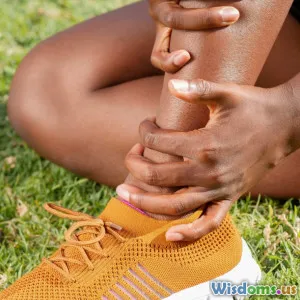
Running vs Cycling Which Cardio Is Best for Joint Health
9 min read Explore which cardio—running or cycling—is better for protecting your joints and promoting long-term joint health. (0 Reviews)
Running vs Cycling: Which Cardio Is Best for Joint Health?
Cardiovascular exercise is vital for overall health and fitness, yet a common concern among many is its impact on joints. Should you hit the pavement pounding the ground with every stride, or is the smooth ride on a bike kinder to your knees and hips? Running and cycling are two popular forms of cardio—but which one truly preserves joint health over time? This article delves deep into the mechanics, benefits, risks, and expert insights surrounding running and cycling to help you decide the best approach for keeping your joints healthy while staying active.
Understanding Joint Health and Cardiovascular Exercise
Joints serve as pivotal connections between bones, allowing the body to move smoothly and efficiently. Key joints involved in running and cycling include the knees, hips, and ankles. Joint health depends on cartilage thickness, synovial fluid lubrication, strong surrounding muscles, and balanced load distribution.
Cardiovascular exercise, defined by rhythmic, repeated muscle movement that raises the heart rate, can have varied impact on joint tissues. While moderate movement nourishes cartilage by enhancing synovial fluid circulation, excessive or high-impact loading can accelerate wear, potentially leading to conditions like osteoarthritis.
The Impact Forces: Comparing Running and Cycling
Running: High-Impact Benefits and Risks
Running is a weight-bearing exercise that subjects joints to significant repetitive impact forces—typically 2.5 to 3 times your body weight on your knees at each foot strike. These forces can stimulate bone density improvements and strengthen muscles but also risk cartilage degeneration in susceptible individuals.
A 2017 study published in the Journal of Orthopaedic & Sports Physical Therapy found that recreational runners exhibited less joint space narrowing—a marker of cartilage health—compared to sedentary controls. However, elite or high-mileage runners may face greater risks of joint pain or injury.
Cycling: Low-Impact and Joint-Friendly
Cycling is classified as a low-impact, non-weight-bearing sport. Because your body weight is supported by the bike, the forces transmitted through your knee and hip joints are markedly reduced compared to running. Additionally, the smooth circular motion reduces peak loading spikes.
Research from the American College of Sports Medicine illustrates that cycling can enhance joint mobility and muscular balance without imposing excessive stress on cartilage, making it particularly suitable for individuals with arthritis or prior joint injuries.
Muscle Strength and Joint Support
Strong muscles act as shock absorbers and stabilizers for joints. Running builds significant bone and muscle strength due to the dynamic forces involved. This can be protective for joint health long-term.
Conversely, cycling predominantly emphasizes the quadriceps and hamstrings but with less eccentric muscle loading. This may result in less robust bone adaptation but still maintains muscular endurance, which is essential for joint stability.
Integrating resistance training alongside either cardiorespiratory option is crucial for maintaining muscle balance around joints and mitigating injury risk.
Joint Injuries and Chronic Conditions
Running-Related Joint Concerns
Common joint injuries in running include patellofemoral pain syndrome (runner’s knee), iliotibial band syndrome, and meniscus tears. These often arise from overuse, biomechanical imbalances, or poor running form.
Long-term high-impact stress can accelerate cartilage wear in some, increasing susceptibility to osteoarthritis—particularly in those with a history of joint injury or obesity.
Cycling and Joint Health Considerations
Cycling is generally considered joint-friendly with lower injury rates. However, improper bike fit or excessive intensity can cause knee pain, particularly related to overuse or malalignment.
For those with osteoarthritis, cycling is often recommended as a preferred cardio due to minimal joint stress while preserving fitness.
Real-World Insights: What Experts Say
Dr. Lisa Mandas, a sports medicine physician, explains, "Running can be excellent for joint health if done with appropriate progression and technique; however, cycling is superior for those managing joint pain or predisposed to arthritis because it reduces loading forces dramatically."
Physical therapist Erin Weber emphasizes the importance of individual choice, "Clients often benefit from cross-training—combining running and cycling—to maximize joint health while enjoying variety. Strength training and flexibility exercises also play vital roles."
Who Should Choose Running?
- Individuals without a history of joint pain or injury
- Those seeking bone density and muscular strengthening benefits
- People looking for high-intensity workouts that improve cardiovascular and muscular fitness
Proper running shoes, gradual mileage progression, and attention to biomechanics can help minimize joint stress.
Who Should Choose Cycling?
- Those with existing joint issues such as arthritis or past injuries
- Older adults requiring low-impact exercise options
- Beginners or individuals needing to build cardiovascular fitness without joint strain
- People desiring longer-duration, endurance-style cardio
With correct bike fit and riding posture, cycling can provide substantial health benefits with minimal joint compromise.
Integrating Both Payments Towards Joint Health
Rather than viewing running versus cycling as an either-or choice, many experts recommend a hybrid approach. For example, combining cycling days with running can maintain cardiovascular fitness while giving joints time to recover from high-impact loading.
Cross-training also reduces repetitive stress injuries and fosters muscular balance.
Conclusion: Which Cardio Is Best for Joint Health?
The truth is, neither running nor cycling universally outranks the other for joint health. It primarily depends on individual factors including fitness level, joint history, existing conditions, and personal preferences.
-
Running offers bone-strengthening benefits and cardiovascular gains but carries a higher risk of joint impact stress, especially if form or recovery is inadequate.
-
Cycling delivers a low-impact alternative preserving joint integrity and promoting muscular endurance without harsh biomechanical loads.
Prioritize mindful exercise selection based on your unique needs, incorporate cross-training, and support your joints with strength training and mobility work. Listening to your body and consulting health professionals ensures your chosen activity benefits both heart and joint health for the long term.
References
- Chang, A., et al., (2017). Impact of Running and Sedentary Lifestyles on Knee Joint Space Narrowing. Journal of Orthopaedic & Sports Physical Therapy.
- American College of Sports Medicine. (2019). Exercise and Arthritis: Position Stand.
- Mandas, L. Interview on Joint Health and Exercise. (2023).
- Weber, E. (2022). Physical Therapy Insights on Cross-Training Benefits. Sports Health Journal.
By carefully weighing these factors, you can choose a cardio regimen that both invigorates your heart and sustains vital joint function for years to come.
Rate the Post
User Reviews
Popular Posts

















